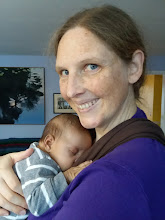Damn, where did November go?
It seems like just yesterday I was paying my October station fees and packing up for Nicaragua. And today the bill was due again, and shortly I’ll be packing up for winter in the States, a decidedly dicier—and icier—proposition than a vacation on Ometepe. I am a little worried about the temperature change. This week a cold front has dropped the nights down into the upper sixties (shudder), and the first night I hardly got any sleep. I would wake up too cold and put on some more bedding, sleep an hour or so, and wake up cold again. In the morning I ended up very bleary-eyed under two blankets and three sarongs. The towels were next in line.
The highlight of the week has been a visit from Brenda, a longtime family friend who’s been in Costa Rica studying Spanish for the past three weeks. She heard rave reviews of the La Selva Thanksgiving celebration from my parents last year, so she decided to come down and check it out for herself. The feast didn’t disappoint—like last year, it featured tiki torches, fireworks, wine, and an endless parade of tempting dishes. And afterwards, following tradition, a group of us went to the Y Griega (a bar down the road) for dancing and karaoke afterwards. Brenda dances a mean merengue, though she declined to join in for the group sing-along of “Like a Virgin.” We stayed till closing (2 am).
Brenda’s a good sport—as well as dancing to dawn, she came to the field with me, helped enter data, helped cook dinner for Steven’s birthday, and joined in the lewd and ludicrous conversations of the researchers. I hope she enjoyed the visit as much as I enjoyed having her here! Probably the most adventurous part of her stay at La Selva was a floating trip on the Rio Puerto Viejo.
On Saturday afternoon, I was sitting on the back porch of the old lab when Detlev (head of the German bat researchers) came running out of the jungle, quite wet. This in itself was not unusual—wet people coming out of the jungle is a daily fixture of station life. The unusual thing was his attire: nothing but a pair of swim trunks.
“Susan, we’re going floating!” he said. “You’ve got to come!”
“Floating where?” I asked him. Ever since the crocodile sightings of the past summer, floating has been generally restricted to the lower reaches of the river.
“Rafael’s house,” he answered cheerfully. It’s a derelict house with beach access, about 600 meters down the SOR—right in the middle of croc territory. But Detlev told me the Germans had all floated downriver once already, and the crocodile hadn’t put in an appearance. I reluctantly agreed to go. After all, it was Saturday afternoon, and the only thing I had planned was more data entry. I put on my Tevas, bathing suit, and sarong, and headed into the forest. Floating from Rafael’s house involves two activities that I generally avoid at all costs: swimming in croc-infested waters, and going into the forest in sandals. Admittedly, “the forest” here is a concrete trail more than a meter wide—but still, not the smartest thing in the world.
On the way out to Rafael’s house, we ran into Brenda, who had been napping at the River Station.
“Susan, what are you doing in the forest in that get-up?” she said. “I thought you said never to go out without boots, and to always wear long pants and long sleeves.”
I explained what we were up to—crocodile and all.
“Oh,” she said. “Wait for me.” A few minutes later, as the three of us headed into the jungle in our bathing suits and sandals. “I must be crazy,” Brenda said. “But I’ll probably be glad I came. When I look back, most of the things I regret are the things I didn’t do.”
As it turned out, we had a quiet, uneventful float down the Puerto Viejo. The crocodile, if he was around, kept a low profile, and the biggest animal we saw was a toucan. Still, I was highly impressed with Brenda’s sang-froid, and with her attitude. In my life, too, the things I regret are usually the opportunities I miss. Brenda’s safely back in the States now, but I hope I’ll be able to keep her spirit of adventure in mind during the last few weeks of my field season.

















